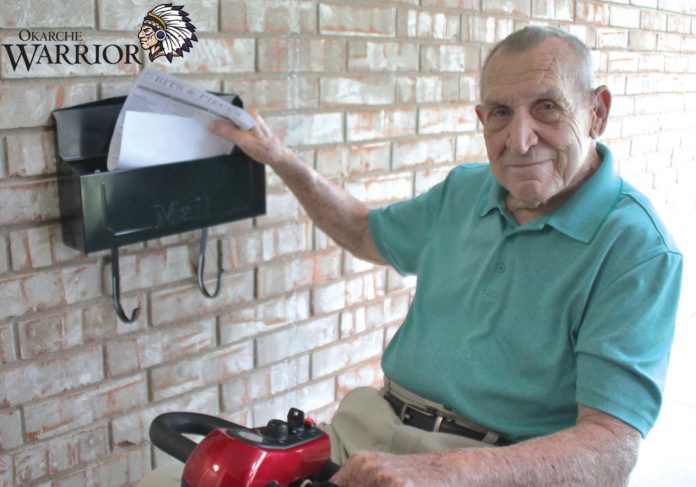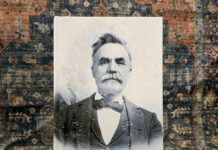
By Carol Mowdy Bond
Contributing Writer
A Spanish Cove resident for 19 years, Ivan Evans is energetic, active, and pleasant, and he loves his life at The Cove. But the combat veteran’s demeanor changes when discussing World War II. The horrors of war are engraved on his brain, and his memory quickly spills out the hard-to-swallow details about his infantry days. And he is quick to say that he didn’t celebrate on VE Day.
Born on a farm 2 miles south of Bessie, Evans spent his life pulling and sacking cotton on his dad’s cotton farm. He married his high school sweetheart one week prior to being graduated from Dill High School.
But Evans said, “I was 19 years-old when I finished high school. And then I was drafted into the U.S. Army.”
That’s when Evans made an earth shattering leap from rural Oklahoma farm boy straight into the military. He landed in Camp Fannin near Tyler, Texas. A U.S. Army infantry training center, the camp provided infantry replacements to various combat sites from 1943 to 1946. Evans was one of over 200,000 U.S. military recruits trained at the camp.
Evans said, “When we got there they said, ‘Men, you are going to have 16 weeks of training and then a boat ride. We’re going to teach you to kill the enemy and if you don’t learn, you probably will get killed.”
From Texas, Evans went to the European Theatre of WW II. Assigned to the 100th Infantry Division with boots on the ground, Evans marched into the belly of the beast. Hitler’s Nazi Germany was making aggressive assaults to finish taking Europe and win the European Theatre of war, and the Allied forces were pushing back with all their might.
Evans stormed the continent at Marseille, France, which is tucked into the coast at the Gulf of Lion on the Mediterranean Sea. Marseille is France’s oldest city. With Italy to the east and Spain to the west, Marseille is near the Rhône River, one of Europe’s most significant waterways.
On foot, Evans initially headed into the Battle of Vosges in France. The Vosges Mountains includes a thickly-wooded forest, covering 60% of the mountain range surfaces. And although the battle was critical to WW II, the battle is often overlooked because the Battle of the Bulge took place at the same time.
Of the Battle of the Bulge in the Ardennes region of Belgium, British Prime Minister Winston Churchill said it was “the greatest American battle of the war.” Lasting six weeks from Dec. 16, 1944, to Jan. 25, 1945, 500,000 American troops were part of the over 1 million Allied troops, with about 19,000 killed in action, and 47,500 wounded, and 23,000 missing. About 100,000 Germans were killed, wounded, or captured. The battle is considered a turning point in the war.
As the Battle of the Bulge exploded throughout the Ardennes, Evans was in the Vosges of France. “The leaves were blowing up around me because the snipers were shooting at us. So I was motivated to dig my foxhole. I dug it about shoulder deep. When you dug your foxhole, if you hit a root you were gonna have running water day and night because it rained so much. So you’re always standing in water and mud. But you couldn’t drink the water. Our next deal was the Maginot Line,” Evans said. Although Evans pronounces it differently, Maginot is pronounced “Ma-shee-new” in the French language. The “sh” is hard, not soft.
Constructed during the 1930s as a line of defense along France’s border with Germany, the French Maginot Line involved 22 large underground fortresses and 36 smaller fortresses, plus blockhouses, rail lines, and bunkers. Although it seemed impenetrable, German troops entered France in May 1940. Parts of the line also extended along the Italian frontier.
“The Maginot Line was a series of underground fortresses built by France after World War I.
I was at the Battle of the Maginot Line at the Town of Bitche. It was one of our worst battles. A bloody battle. Germans had taken the town. One of the fortresses, near Schiesseck, had walls at least five feet thick, reinforced with steel. Bombs didn’t impact them. As many as 800 men could stay in each of the underground fortresses. They had their own food supply, medical operating rooms, and other. Germans had taken the fortresses and were staying in them. They were quite high tech. Each fortress had a ‘pill box’ on land and a gun turret rose out of the ground and then went down inside. Germans were on the ground on the Maginot Line. But we stayed in our foxholes,” Evans said.
Evans carries a prized card in his wallet, proof of an honor he received. “We liberated the town of Bitche from the Germans. So the people of Bitche honored us by naming us their ‘Sons of Bitche,’ and they gave us these cards,” Evans said.
“I was wounded in this battle. The German who shot me came up out of one of the fortresses and he was behind me. He had an automatic weapon. One bullet hit me in the arm. One bullet hit another man who died. There was so much battle that we could not get off the line. We all carried sulfur powder, and I put sulfur powder in my wound. Next I went to an aid station, then to a MASH unit. Then I was sent to the 36th General Army Hospital at Dijon, France. I was there about seven weeks, and then went back to the front lines,” Evans said.

During WW II, troops used sulfur powder to reduce risks of infections in their wounds. MASH is an acronym for Mobile Army Surgical Hospital. The U.S. Army medical units functioned as hospitals in combat zones.
Evans was involved in a lot of skirmishes. After those, he said, “We crossed the Rhine River at Mannheim. Our next bloody battle was at Heilbronn, Germany, at the Neckar River. France has been liberated. We’re now in Germany. I was part of the 3rd Battalion. We paddled across the river in assault boats about 3 a.m. and we set up a beachhead hoping our engineers could build a bridge to get equipment across the river. But we couldn’t get a bridge built as the Germans kept knocking it out. The battle lasted nine days. We were surrounded by Germans and we could not get back across the river. But the U.S. military surrounded the Germans. The battled destroyed Heilbronn. In that battle, 1,769 Germans were taken as prisoners, and more than that were killed or wounded.”
The Battle of Heilbronn was fought for nine days during April 1945. One of the Rhine River’s major tributaries, the Neckar River is located between Stuttgart, Germany, and Heidelberg, Germany.
The European Theatre’s final battles, and overall surrender of Nazi Germany to the Allied forces, took place in late April and early May 1945.Victory in Europe Day, also known as VE Day, occurred on May 8, 1945. The Pacific Theatre of WW II was ongoing. So, victory was only declared in Europe.
Although there were VE Day celebrations in some parts of Europe, Evans and his unit didn’t celebrate. “The Battle of Heilbronn was fought about three weeks before VE Day. We were all upset and quiet on VE Day. We weren’t celebrating because the war didn’t end before this battle. Because we lost so many of our troops,” Evans said.
Since he had been wounded, Evans was given a choice. He could move on with his unit to the Pacific Theatre of War in Japan, or stay in Europe. “I chose to stay in Jan. 1946 as the Army of Occupation in Germany, about 40 to 50 miles north of Stuttgart. I was part of the occupation for seven months. The Army of Occupation stayed there for several years,” Evans said.
As the recipient of a Purple Heart and a Bronze Star, Evans flew home to his wife. Together they attended Oklahoma A&M, now Oklahoma State University. Evans earned a bachelor’s degree in education, with more education on top of that. His wife earned a degree in business administration.
Evans retired from a 40 year career in education, during which time he coached, taught school, and he was a high school principal.
In 1993, he and his wife returned to Europe. “We covered the ground that my unit covered in WW II, and you could still see indications of our foxholes,” Evans said.
Now Evans is a well-known courier at Spanish Cove. He motors around The Cove, weekly delivering the “Bits and Pieces” newsletter to residents in the cottages. And once a month he delivers the “Spanish Cove Spirit” periodical to all residents. Of The Cove he said, “It has been a great blessing to me and my wife and we’ve really enjoyed it. It’s a great big wonderful family.”
Married almost 69 years, Evans and his wife have one son, two grandsons, and three great-grandchildren. “I wouldn’t be here talking to you if God hadn’t got me through. I’ve lived a good life. If God were to tell me He’d give me a new life, I wouldn’t take it. I wouldn’t change a thing.”






